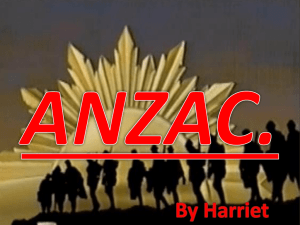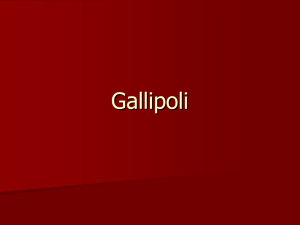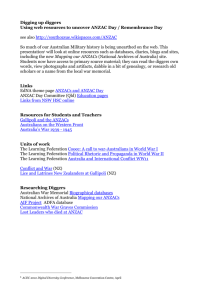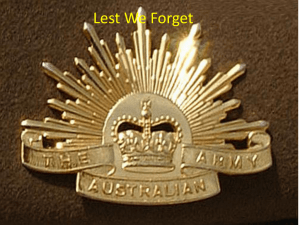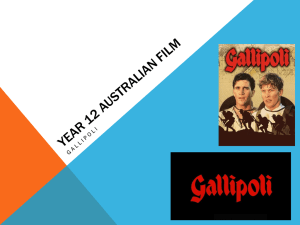Paul-Baker_Qld
advertisement
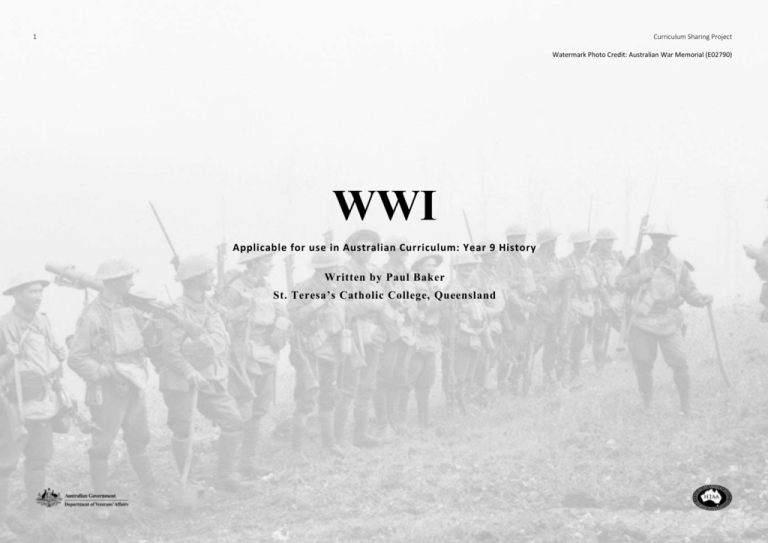
1 Curriculum Sharing Project Watermark Photo Credit: Australian War Memorial (E02790) WWI Applicable for use in Australian Curriculum: Year 9 History Written by Paul Baker St. Teresa’s Catholic College, Queensland 2 Curriculum Sharing Project This Unit is taught over a ten-week period. 3 Curriculum Sharing Project Table of Contents AIMS AND OBJECTIVES 4 COURSE OVERVIEW 5 RESOURCES LIST 15 MEDIA RETELLING TASK 17 BATTLES 17 CONDITIONS OF THE TRENCHES 18 HISTORY TRIVIA QUIZ 20 HISTORY TRIVIA QUIZ QUESTIONS 20 HISTORY TRIVIA QUIZ ANSWER SHEET 24 EXTENDED WRITTEN RESPONSE (IN-CLASS ESSAY) 25 ESSAY PLAN 26 100 WORDS OF NOTES 28 STIMULUS – FIVE QUOTATIONS 29 EXTENDED WRITTEN RESPONSE CRITERIA 30 4 Curriculum Sharing Project Aims and Objectives Knowledge and Understanding An overview of the causes of World War I and the reasons why men enlisted to fight in the war. The places where Australians fought and the nature of warfare during World War I, including the Gallipoli campaign. The impact of World War I, with a particular emphasis on Australia (such as the use of propaganda to influence the civilian population, the changing role of women, the conscription debate). The commemoration of World War I, including debates about the nature and significance of the Anzac legend. Skills Inquiry question formation (ACHHS166) Sequence chronologically (ACHHS164) Origin and purpose of sources (ACHHS169) Synthesising information from sources (ACHHS170) Reliability and usefulness of sources (ACHHS171) Motives, values and attitudes of people (ACHHS172) Develop historical texts (ACHHS174) Range of communication forms (ACHHS175) 5 Curriculum Sharing Project Course Overview Week Lesson Content/Activities 1 1 Lesson Focus Introduction to WWI, the Anzac Legend and exploration of why Anzac is considered a “sacred” moment in history for Australian society. Learning Activities Get students to create a “Year 9 History” folder on your computer and a Word document that you will use to copy information for the term. You will need to include a glossary to list new or unusual words. Carry out a class “brainstorm” about student knowledge of WWI. Encourage thoughts about causes, battles, outcomes and personal family stories using your discretion as to when to end the exercise. Get the students to create a Word document titled “Australia and the Great War 1914–1918”. Tell students that they will be answering the “who”, “what”, “where”, “when” and most crucially the “why” of History, but will look at three initial inquiry topics during the term: – Why did World War I happen? – What was Australia’s role? – What was the war’s impact on the Australian home front? Watch the film clip, which is particularly relevant to the final question. Use the clip to promote the understanding of primary and secondary sources, the black and white footage being primary and the colour secondary. www.youtube.com/watch?v=8UcvJi8klz8 State/Territory and ACARA curriculum links (ACDSEH097) (ACHHS166) (ACHHS169) (ACHHS175) Assessment 6 Curriculum Sharing Project Week Lesson 2 Content/Activities Lesson Focus As the Unit is planned as part of the Anzac commemoration this class will focus on preparation for Anzac Day. State/Territory and ACARA curriculum links (ACDSEH097) (ACHHS166) (ACHHS169) (ACHHS175) (ACDSEH021) (ACHHS164) (ACHHS170) (ACHHS174) (ACHHS175) Learning Activities Ask the students the questions “What is Anzac Day?” and “What does Anzac Day stand for?” After discussion of this question, display a copy of the “Ode” and get students to recite it as a group (this is partly a rehearsal for the Anzac Day ceremony). Get students to create a page/Word poster with the “Ode” in the centre and images that they believe reflect Anzac around it. The students will develop skills as they do this as they will be required to use correct referencing to create a bibliography of their resources. www.users.on.net/~revelation/schools.htm www.dva.gov.au/commems_oawg/commemorations/commerative_events/Pages/ode.aspx 2 3–5 World War I – Causes Lesson Focus The “Boiling Point” in 1914 that sets the world on to the course of war. The term M.A.N.I.A. (Militarism, Alliances, Nationalism, Imperialism and Arms Race) is introduced and used to explore the 20th century European setting and the nations and countries that controlled it. Inquiry Question "What causes led to the largest loss of human life, at that time, in recorded history?" Learning Activities Establish the concept of M.A.N.I.A = Militarism, Alliances, Nationalism, Arms Race (The Prezi in your research folder will introduce this – students to note-take). Each of these topics will be about 25 minutes each (two per lesson – you don't want to rush it). Militarism “A little story about Germany.” Have students research the definition of militarism and write in down in their own words on a new tab in their Word document, “Glossary” – Introduce students to the concept of direct/in-direct referencing and the concept of paraphrasing. Demonstrate with an example in class. Assessment 7 Curriculum Sharing Project Week Lesson Content/Activities Students will then visit the following website which explores Germany and its rise in militarism leading up to 1914. In essence it explains that Germany as a newly unified nation was playing catch-up to the other European powers. Have students practise summarising key points. Alliances Video – “World War I – Which Countries Fought” www.youtube.com/watch?v=HMo4rxmsBDg (3½ minutes) Quiz students at the end with 5–10 questions that you will formulate. (Prior viewing is necessary.) Nationalism “A little story about France.” Key terms: Patriotism, National Identity, and National Pride. Start discussion with the question “What does it mean to be Australian?” and then use that as a lead into reminding them that in 1789 France a revolution took place that saw the birth of the above ideas/key terms – have students add these terms to their glossary and then (optional) create a Keynote on “What it means to be German/French/English”. What do we think of when we associate people to those countries? (Also a good opportunity to challenge stereotypes and misconceptions.) Imperialism “A little story about the British Empire” activity map, colouring in. Can be used in conjunction with Alliances to establish who, what, where when – ensure students add that detail in the map’s key. Students will need to research the major powers (Triple Alliance, Triple Entente) and colour in who controlled what. Arms Race Watch Sherlock Holmes 2 for a visual perspective (leads on from the Industrial Revolution). Recap the Industrial Revolution (i.e. mechanization and mass industry). Question: “What could be a negative by-product of the Industrial Revolution – mechanization and large scale industry?” Have students write a 50-word personal response to the video. State/Territory and ACARA curriculum links Assessment 8 Curriculum Sharing Project Week Lesson 3 6 Boiling Point – The Assassination of Archduke Franz Ferdinand Content/Activities Lesson Focus This lesson’s focus is on the critical event that would cause the alliance and entente system (systems designed to prevent war) to become the one of the causes of all the major European empires of the world being drawn into armed conflict. The human side of the assassination will be explored through study of Gavrilo Princip and the reasoning that caused him to assassinate Archduke Franz Ferdinand. Learning Activities Students will begin with watching a brief video on the “Causes of the First World War” – www.youtube.com/watch?v=njINCi9iIrA (2 minutes). Students will take notes and be quizzed at the end; suggest that you develop five questions. Have students research and complete a biography on Gavrilo Princip (you could provide a WebQuest here of your own design). This will give them an opportunity to see the human story of a man who created a conflict greater than he ever intended. (30 minutes) www.spartacus.schoolnet.co.uk/FWWprincip.htm (link could assist) Have students fill out the “Causes of World War I” diagram on page 245 of the Cambridge Textbook for homework (Woollacott, Angela (editor) (2012). History 9 for the Australian Curriculum, Cambridge First, Port Melbourne.). – This will provide an opportunity to use MANIA to look at the background causes that occurred leading up to the assassination so that it is seen as the spark rather than the cause of the World War. – Ensure to go through this next lesson – this will provide you an opportunity piece together the MANIA as the background/causes that see an assassination explode into all out World War. State/Territory and ACARA curriculum links (ACDSEH021) (ACHHS169) (ACHHS170) (ACHHS171) (ACHHS172) (ACHHS175) Assessment 9 Curriculum Sharing Project Week Lesson 7 Reactions to War Enlisting to Fight Content/Activities Lesson Focus The later part of the week focuses on the reaction of the European nations and the propaganda that ensued. Learning Activities Reactions to War As a class, begin reading page 246 from History 9 for the Australian Curriculum – including “Time Goes By”, and challenge the students to think about the source and the associated questions as a class. The source is suggesting that logic and reason go out the window when the opportunity to appear brave and patriotic arises. – Ask the questions “What would you fight for?” and “What would you die for?” if you think students can respond maturely. – Have students continue reading p247–249 and complete Activity 7.3 page 249. – Go through answers as a class. Finish with explaining how people all around the world/nations rejoiced at the idea of war challenge students to think of why. (Use images from the internet of the cheering crowds in each of the European capital cities.) Enlisting to Fight As a class, read pages 250–251 and bring in some propaganda posters (Google Images is also a good source). Have students read pages 252–253. Students to complete Activity 7.4 on page 253 – might need to go through Source 7.17 and unpack it (statistics on enlistment). Finish with reading “Time Goes By”, page 253. It explores one-person reasons for joining the war – great primary source. State/Territory and ACARA curriculum links (ACDSEH021) (ACHHS169) (ACHHS170) (ACHHS171) (ACHHS172) (ACHHS175) Assessment 10 Curriculum Sharing Project Week Lesson 4–5 8–15 Trench Warfare Content/Activities Lesson Focus The focus is to familiarise students with the locations/campaigns and the involvement of Australian troops in Europe. This work will then lead into the nature of the war that was fought in Europe. A key component of this work is mapping and research into key figures. This research will then be used to enable annotation of the maps. Learning Activities Where Australians fought and the nature of warfare (Textbook Woollacott. Angela, (editor), History 9 for the Australian Curriculum, Cambridge First, Port Melbourne 2012: pages 255– 256). It is important that the students get an understanding of not just where the Australians fought, but also why they fought in WWI and at Gallipoli and the Western Front in particular. – Students should produce a map showing Australia’s involvement with detailed reference to campaigns and results. This is to be completed on a black line master of Europe and North Africa (to be provided by the classroom teacher). Students should be able to research lots of additional information such as casualties, numbers involved in the campaigns and duration of the campaign. – Refer to “assessment” folder and choose one of the “Assessment for Learning” tasks, either Battles or Trench Warfare; break the students into groups and provide three lessons for research and one for presentation. Follow the instructions on the task sheet. Peer assessment is also possible given the nature of the assessment criteria. – See the Resources List for DVA websites that are excellent for research on these tasks – highly recommend their use. State/Territory and ACARA curriculum links (ACDSEH021) (ACHHS164) (ACHHS166) (ACHHS169) (ACHHS170) (ACHHS171) (ACHHS172) (ACHHS174) (ACHHS175) Assessment Assessment for Learning task 11 Curriculum Sharing Project Week Lesson 6 Gallipoli Content/Activities Lesson Focus The focus of this week is to explore the nature of the campaign on Gallipoli and to empathise with the soldiers involved as they experience the conflict. Learning Activities Students should watch the film Gallipoli, directed by Peter Weir, from the beach-landing scene up until the conclusion, noting references to strategy, the type of warfare and the likelihood of success. (Your library should have a copy.) There are so many good resources on Gallipoli that could be used to meet the content focus. Remind students of the work that they have completed on the Ode from their exploration of Anzac Day in the previous week. A possible activity for a Gallipoli reflection is for students to put themselves in the position of a combatant; based on what they see in the film, explaining what has been going on around them and with the knowledge that they are “going over the top” tomorrow. Write a letter home to a loved-one that outlines how they are feeling, both from a fear perspective and from the view that they are proud of what they are doing. A good case study is the last scene in the film Gallipoli and the assault on the Nek. www.awm.gov.au/units/event_133.asp Focal point: Why is it that this event, in the eyes of many, contributes so much to our identity as a nation, and yet we were fighting for the British and the whole campaign was such a failure? – Students are to “Think, Pair and Share” (T/P/S) once they have studied the websites listed under resources. Two of the resources provide counter arguments about the contribution of the Anzac campaign to the identity of Australia. – After investigation of all the sites the students are to write a paragraph that answers, in their view, the following question: “Why do so many Australians believe Gallipoli contributes so much to the identity of Australia as a nation?” State/Territory and ACARA curriculum links (ACDSEH021) (ACHHS164) (ACHHS166) (ACHHS169) (ACHHS170) (ACHHS171) (ACHHS172) (ACHHS174) (ACHHS175) Assessment Write a letter home 12 Curriculum Sharing Project Week Lesson 7 Western Front Content/Activities Lesson Focus Focus is on the Western Front, but in depth. Learning Activities Students map the Western Front in greater detail than previous map, showing specific rivers, towns, mountains and other features (blank map will need to be provided). You could use this part of the unit to explore some associated geographic skills. There is great scope for a multidisciplinary approach in this section. Have students find Australian War Graves at Fromelles and Villers-Bretonneux on Google Maps. It is a good exercise that shows the scope of the losses and the impact that Australian involvement has had on the French to preserve so many graves. (See Resources List for useful websites.) Possibly show sections of Beneath Hill 60 to demonstrate the horrible conditions of trench warfare. The following website will give you information about this film and its availability: www.beneathhill60.com.au. Students should research the following terms and enter them into their glossary: – no man’s land – trench foot – trench fever – shell shock – poison gas – attrition warfare. (This could be completed as an option instead of the assessment in Week 4.) State/Territory and ACARA curriculum links (ACDSEH021) (ACHHS164) (ACHHS166) (ACHHS169) (ACHHS170) (ACHHS171) (ACHHS172) (ACHHS174) (ACHHS175) Assessment Map of Western Front 13 Curriculum Sharing Project Week Lesson 8 Casualties Content/Activities Lesson Focus The focus is to evaluate the extent to which casualties of war affected Australia as a nation and whether these casualties and the war helped in shaping Australia’s identity. The sense of national pride in Australia’s involvement will be compared to the Nationalist concept discussed under the M.A.N.I.A. work in Week 2. Learning Activities Continuing from the previous week looking at war graves, students are to complete this section with a review of the casualties recorded in diagrammatic form on pages 264–266 of the textbook (Woollacott. Angela, (editor), History 9 for the Australian Curriculum, Cambridge First, Port Melbourne 2012). Undertake the review questions. Discussion: What lessons should we have learned from this war? This method of fighting? Discussion: Why is Anzac Day experiencing a renaissance in terms of its meaning for the young in Australia when 25 years ago, interest in it was rapidly diminishing? Complete Activity 7.7 (Textbook Woollacott. Angela, (editor), History 9 for the Australian Curriculum, Cambridge First, Port Melbourne 2012) and do a lesson on the Unknown Soldier (the one interred in Canberra) as well as conduct a discussion on the fact that there are so many graves of Australians with no names around Europe and the world. Letters to and from home would be very powerful and emotional primary source material. www.lidgate.suffolk.gov.uk/ww1.html State/Territory and ACARA curriculum links (ACDSEH021) (ACHHS164) (ACHHS166) (ACHHS169) (ACHHS170) (ACHHS171) (ACHHS172) (ACHHS174) (ACHHS175) Assessment 14 Curriculum Sharing Project Week Lesson 9–10 Essay Preparation Content/Activities Lesson Focus The focus of these concluding classes is preparation for the summative assessment. Learning Activities In the “assessment” folder you will find the Argumentative Essay task “Assessment of Learning”, which is the summative assessment for this unit. The students have an option as to which topic they attempt. You will need to use the handouts on skills and use several lessons provided to go over: – thesis formation – citing. By Week 9 provide the students with the scaffolding and allow them two lessons to research their five quotations. Offer advice on the quality of their selection in terms of a balance between primary and secondary, their representativeness and their effectiveness in enhancing the support of their thesis. After completing the essay under exam conditions, if there is any time left, you could complete this unit by reflecting on some W.H Auden poetry or other material that allows the concept of either a just war, the futility of war or some other aspect of this “Great War” to be explored. Another alternative is to go to your Resource Folder and use the Trivia Quiz to test their understanding in a competitive and interesting way. State/Territory and ACARA curriculum links (ACDSEH021) (ACHHS164) (ACHHS166) (ACHHS169) (ACHHS170) (ACHHS171) (ACHHS172) (ACHHS174) (ACHHS175) Assessment Assessment of Learning 15 Curriculum Sharing Project Resources List Week Lesson Resources 1 1 Websites www.youtube.com/watch?v=8UcvJi8klz8 2 Websites www.users.on.net/~revelation/schools.htm www.dva.gov.au/commems_oawg/commemorations/commerative_events/Pages/ode.aspx 2 Websites www.youtube.com/watch?v=HMo4rxmsBDg 3 Books Woollacott, Angela (editor) (2012). History 9 for the Australian Curriculum, Cambridge First, Port Melbourne. Websites www.youtube.com/watch?v=njINCi9iIrA www.spartacus.schoolnet.co.uk/FWWprincip.htm 4–5 Books Woollacott, Angela (editor) (2012). History 9 for the Australian Curriculum, Cambridge First, Port Melbourne. Websites DVA websites Australians at War www.australiansatwar.gov.au Australians on the Western Front 1914–18 www.ww1westernfront.gov.au Australians at War Film Archive www.australiansatwarfilmarchive.gov.au/aawfa Gallipoli and the Anzacs http://anzacsite.gov.au 16 Curriculum Sharing Project Week 6 Lesson Resources Websites www.awm.gov.au/units/event_133.asp Gallipoli – the First Day www.abc.net.au/innovation/gallipoli www.abc.net.au/innovation/gallipoli/gallipoli2.htm http://theage.com.au/comment/anzac-day-thecurious-notion-of-australias-birth-at-gallipoli-20140424-zqyll.html www.abc.net.au/news/2014-04-25/five-anzac-myths-put-to-the-test/5393750 Videos Gallipoli (1981). [DVD] Directed by Peter Weir. 7 Websites Overseas memorials http://memorials.dva.gov.au Office of Australian War Graves www.dva.gov.au/commems_oawg/OAWG/Pages/index.aspx www.beneathhill60.com.au 8 Books Woollacott, Angela (editor) (2012). History 9 for the Australian Curriculum, Cambridge First, Port Melbourne. Websites www.lidgate.suffolk.gov.uk/ww1.html 17 Curriculum Sharing Project Media Retelling Task Battles Battles of: Select one of the following battles for your study: The Battle of Passchendaele The Battle of Verdun The Battle of Fromelles The Battle of Villers-Bretonneux The Battle of the Somme The Nek (Gallipoli). Task Instructions Your task is to teach the class the story of your chosen battle. You have explored the causes of the war and investigated the nature of trench warfare. Now you need to tell the stories of what happened. Develop some inquiry questions (your teacher will check them) to guide your deep investigation. Ensure you look at some personal stories from the battle. Form arguments using evidence that detail why your battle happened (What were its goals/aims?) and what were the results. You will need to locate your battle on a larger map of the country where it occurred and then a smaller more specific one. You need to look at dates, start/finish/length/etc. as well as which armies were involved. Document casualties – injured, deaths, missing. Tell your story of the battle you chose using either Keynote or iMovie. Collect images, develop a chronology of the battle and develop a script you will use to tell the story. With the accompanying visuals, your group and you (no more than four) will be the experts teaching the class about the nature/direction/importance of this significant battle. Ensure you use reputable and reliable sources and reference them in credits at the end of your presentation. Your story should be approximately 2 to 3 minutes long and should be visually interesting and informative. Use the Keynote tutorial or the iMovie tutorial below if you need help. www.apple.com/iwork/tutorials/#keynote-hero www.apple.com/support/imovie 18 Curriculum Sharing Project Conditions of the Trenches Select one of the following elements of trench warfare as a focus for your study: no man’s land machine guns artillery poison gas attrition warfare aircraft flame throwers tanks trench foot trench fever. Task Instructions Your task is to teach the class the story of your chosen condition of trench warfare. You have explored the causes of the war and investigated the nature of trench warfare. Now you need to tell the stories of what happened. Develop some inquiry questions (your teacher will check them) to guide your deep investigation. Ensure you look at some personal stories from the front. Form arguments using evidence that detail how and where your “condition” could be found. You will need to locate your condition on a larger map of the country where it occurred and then a smaller more specific one. You need to look at dates, as well as which armies used/were affected by them. Document the effect it had during the war on the troops and use personal letters from soldiers as supporting information. Tell your story of the battle you chose using either Keynote or iMovie. Collect images, develop a script you will use to tell the story with the accompanying visuals; your group and you (no more than four) will be the experts teaching the class about the nature and importance of this significant condition. Ensure you use reputable and reliable sources and reference them in credits at the end of your presentation. Your story should be approximately 2 to 3 minutes long and should be visually interesting and informative. Use the Keynote tutorial or the iMovie tutorial below if you need help. www.apple.com/iwork/tutorials/#keynote-hero www.apple.com/support/imovie 19 Curriculum Sharing Project History Learning Intention Feedback You have done the following well: You need to work on: You can do this by... Achievement Level 20 Curriculum Sharing Project History Trivia Quiz Rules Teams of 4–6 students (mixed groups). Each team named after a country: Australia, France, Germany, Great Britain, Turkey and Russia. General to be in charge of each country. Rounds of five questions – each question worth between 1–3 points. Maximum amount a team can score in seven rounds is 60 points. Bonus Questions are worth 5 points each in Rounds 3, 5 and 7. Time allowed – 1 minute included reading time each question. No yelling out answers or talking to other Countries. Answers to be read out at the end of Rounds 2, 4, 6 and 7. Winners to be awarded a “glow bangle” or other suitable prize. In the event of a tie (more than 10 people) heads and tails will decide the winner (either with coins, or hands on head/tail, etc.). No phones or iPads to be used (to be placed the floor or at the front of classroom). History Trivia Quiz Questions Round 1 (9 Points) 1) What does the acronym “ANZAC” stand for? (1 point) Answer: Australian and New Zealand Army Corps 2) What was the name of the Archduke of the Austro-Hungarian Empire that was assassinated? (1 point) Answer: Archduke Franz Ferdinand 3) In what year and month did Germany declare war on Russia and France? (2 points) Answer: August 1914 4) Name two Empires or countries that joined Germany in World War I. (2 Points) Answer: The Austro-Hungarian Empire, the Ottoman Empire (Turkey), and Bulgaria 5) Name three Allies of France in World War I. (3 points) Answer: The British Empire (including Australia, New Zealand, Canada), The Russian Empire, Serbia, Italy, Portugal, Greece, United States, Japan, China, India, Belgium and Romania 21 Curriculum Sharing Project Round 2 (9 points) 6) What was World War I first called or named before being known as World War I? (1 point) Answer: The Great War 7) What was the official day/month/year Australia became involved in World War I? (3 points) Answer: 5 August 1914 8) What country is the now Anzac Cove part of? (1 point) Answer: Turkey 9) What was the official date of the landing at Anzac Cove? (3 points) Answer: 25 April 1915 10) What animal did the famous soldier John “Simpson” Kirkpatrick use to help wounded troops in Gallipoli? (1 point) Answer: A donkey Round 3: Bonus Round (Maximum 10 points) 11) What is “attrition” warfare? (5 points) Answer: The wearing down of enemy by constant attack 12) Which country first introduced chemical warfare (tear gas) on the Western front? (1 point) Answer: French 13) Name the two countries the Western Front ran through or bordered. (2 point) Answer: France, Belgium 14) Australia’s first major engagement on the Western Front in July 1916 was known as the Battle of? (1 point) Answer: Battle of Fromelles 15) What year was the battle of the Somme? (1 point) Answer: 1916 22 Curriculum Sharing Project Round 4 (Maximum 6 points) 16) What year was the battle of Passchendaele? (1 point) Answer: 1917 17) Which battle was known as Australia’s worst “single” wartime loss? (1 point) Answer: Battle of Fromelles 18) Name two weapons commonly used in World War I. (2 points) Answer: Poison gas, tanks, flame-throwers, machine guns, rifle, bayonet rifle, zeppelin, planes, torpedoes, knife 19) In what country is the town of Villers-Bretonneux? (1 point) Answer: France 20) Australia’s war casualties, as a proportion of the overall population were: (1 point) a) the highest of all the fighting nations b) the highest of the British Empire c) lower than those of Britain or New Zealand d) higher than those of Germany or France Round 5 (Maximum 10 points) 21) In the movie Gallipoli, which was shown in class, how did the two main characters played by Mel Gibson and Mark Lee meet? (1 point) Answer: At a carnival where they raced each other in a foot race 22) To what country were the characters in the movie Gallipoli first sent for training before going to Gallipoli? Which sea borders the north of this country? (2 points) Answer: Egypt, the Mediterranean Sea 23) In the film Gallipoli, what state did the main characters come from? (1 point) Answer: Western Australia 24) What major event or miscalculation happened in Gallipoli (and recorded in history) that caused the mix up of when the troops were to go over the “wall”? (1 point) Answer: The watches of the officers were not synchronization or timed exactly the same as each other 25) What was the narrow stretch of land the Australian’s were trying to capture in the movie Gallipoli called? (Bonus 5 points) Answer: “The Nek” 23 Curriculum Sharing Project Round 6 (Maximum 7 points) 26) What does the Acronym RSL stand for in modern day? (1 point) Answer: Returned Soldiers League 27) What are the colours of the Australian flag? (1 point) Answer: Blue, red and white 28) The Australians who fought on horseback in the First World War were known as the Answer: Australian Light Horse 29) In which state or territory can the Australian War Memorial be found? (1 point) Answer: ACT 30) When did Germany sign the armistice that ended fighting on the Western Front? (3 points) Answer: 11 November 1918 Round 7. General Trivia (9 points) 31) What was the most common weapon Australian troops carried during the Great War? (1 point) Answer: Rifle fitted with a bayonet 32) At what age could you officially join the armed forces in 1914 in Australia? (1 point) Answer: 21, but 18 if your parents approved 33) What date is Anzac Day commemorated each year in Australia? (1 point) Answer: 25 April 34) On what date do we celebrate Armistice Day? Why? (5 points) Answer: 11 November, Cessation of WWI Allies and Germany 35) What is the game of two-up played with? (1 point) Answer: Two pennies (accept coins) ? (1 point) 24 Curriculum Sharing Project History Trivia Quiz Answer Sheet NAME: Team Australia Germany UK Austria France Turkey Round 1 Round 2 Round 3 Round 4 TEACHER: Round 5 Round 6 Round 7 Bonus Points 25 Curriculum Sharing Project Extended Written Response (In-Class Essay) Summative Assessment TASK: DUE DATE: / / Over this term you have been exploring the First World War (1914–1918). World War I was one of the most important events of the 20th century. It created enormous change in the nations that took part in it, including Australia. You are to construct an argumentative essay which clearly states a thesis which explains whether you agree/disagree with the topic. In your essay you must analyse primary and secondary evidence. Topics You are required to choose one (1) of the topics below and discuss whether you either agree or disagree with the statement when formulating your thesis. 1) Of all the causes of WWI, clearly the one that was most responsible for starting the Great War was the system of alliances; any other cause is less important. or 2) The evolution of weaponry meant that World War I was only ever going to be fought in one way – in trenches. Conditions 100 words of notes (must be signed by your teacher before the essay is attempted). Length: 400–500 words. Students are to work individually and independently. Class time and student home time will be used. Time 10 minutes reading. 70 minutes writing. Criteria Criterion 1: Historical Understanding Criterion 2: Historical Skill 26 Essay Plan Introduction Topic Sentence Identify subject matter and outline Main Argument (hypothesis). Developing Sentences Preview of argument (aspects to be addressed in each body paragraph): Overview of Argument 1, 2, 3 etc. Concluding Sentence Link to next paragraph using your hypothesis. Argument 1 Topic Sentence Aspect considered in this paragraph. Elaboration (supporting and developing sentences) 1–3 pieces of evidence that support this aspect. Concluding Sentence Summarising (link back to hypothesis). Argument 2 Topic Sentence Aspect considered in this paragraph. Elaboration (supporting and developing sentences) 1–3 pieces of evidence that support this aspect. Concluding Sentence Summarising (link back to hypothesis). Curriculum Sharing Project 27 Argument 3 Topic Sentence Aspect considered in this paragraph. Elaboration (supporting and developing sentences) 1–3 pieces of evidence that support this aspect. Concluding Sentence Summarising (link back to hypothesis). Conclusion Topic Sentence Restatement of hypothesis (theory). Elaboration (Developing and Supporting sentences) Support theory by restating the key argument points. Concluding Sentence Summarise arguments and link back to hypothesis in proving your theory. Curriculum Sharing Project 28 100 Words of Notes Curriculum Sharing Project 29 Stimulus – Five Quotations 1) 2) 3) 4) 5) Note: You are allowed to bring in five quotations of your choosing (your teacher will sign this off before the essay). Curriculum Sharing Project 30 Curriculum Sharing Project Extended Written Response Criteria Criteria A B C D E Informed explanations of: patterns of change and continuity over time with reference to key events, the actions of individuals and groups, and beliefs and values different interpretations of the past and the evidence used to support these interpretations analysis of the causes and effects of historical events and developments, and explanation of their relative importance and the context for people’s actions in the past. Explanations of: changes and continuities over time with reference to key events, the actions of individuals and groups, and beliefs and values different interpretations of the past and the evidence used to support these interpretations description of the causes and effects of historical events and developments with reference to their importance and the motives and actions of people in the past. Explanations of: obvious changes and continuities over time with some reference to key events and the actions of individuals and groups different interpretations of the past description of the causes and effects of historical events and developments with some reference to the motives and actions of people in the past. Statements of: no obvious changes and continuities over time with some reference to key events and the actions of individuals and groups description of the causes and effects of historical events and developments. The student work has the following characteristics: Historical Understanding Reasoned explanations of: patterns of change and continuity over time with reference to key events, the actions of individuals and groups, and beliefs and values varied interpretations of the past and the evidence used to support these interpretations reasoned analysis of the causes and effects of historical events and developments, and explanation of their relative importance and the context for people’s actions in the past. 31 Curriculum Sharing Project Criteria A C D E Comprehensive analysis and synthesis of information from a range of primary and secondary sources, including the identification of motivations, values and attitudes. Significant analysis and synthesis of information from a range of primary and secondary sources, including the identification of motivations, values and attitudes. Analysis and synthesis of information from a range of primary and secondary sources, including the identification of motivations, values and attitudes. Superficial analysis of some historical sources with identification of obvious motivations, values and attitudes. Use of some historical sources. Reasoned evaluation of the origin, purpose and context of historical sources that determines their worth, relevance and reliability as evidence for inquiries. Informed evaluation of the origin, purpose and context of historical sources that determines their relevance as evidence for inquiries. Evaluation of the origin, purpose and context of historical sources that determines their usefulness as evidence for inquiries. Superficial evaluation of historical sources that makes decisions about their usefulness as evidence for inquiries. Use of obvious historical sources connected to inquiries. Historical Skills Comments: B
